Related Research Articles

A shoe is an item of footwear intended to protect and comfort the human foot. Shoes are also used as an item of decoration and fashion. The design of shoes has varied enormously through time and from culture to culture, with appearance originally being tied to function. Though the human foot is adapted to varied terrain and climate conditions, it is still vulnerable to environmental hazards such as sharp rocks and temperature extremes, which shoes protect against. Some shoes are worn as safety equipment, such as steel-soled boots which are required on construction sites.

Footwear refers to garments worn on the feet, which typically serves the purpose of protection against adversities of the environment such as ground textures and temperature. Footwear in the manner of shoes therefore primarily serves the purpose to ease locomotion and prevent injuries. Footwear can also be used for fashion and adornment as well as to indicate the status or rank of the person within a social structure. Socks and other hosiery are typically worn additionally between the feet and other footwear for further comfort and relief. Cultures have different customs regarding footwear. These include not using any in some situations, usually bearing a symbolic meaning. This can however also be imposed on specific individuals to place them at a practical disadvantage against shod people, if they are excluded from having footwear available or are prohibited from using any. This usually takes place in situations of captivity, such as imprisonment or slavery, where the groups are among other things distinctly divided by whether or whether not footwear is being worn. In these cases the use of footwear categorically indicates the exercise of power as against being devoid of footwear, evidently indicating inferiority.
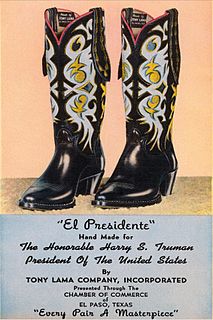
A boot, plural boots, is a type of footwear. Most boots mainly cover the foot and the ankle, while some also cover some part of the lower calf. Some boots extend up the leg, sometimes as far as the knee or even the hip. Most boots have a heel that is clearly distinguishable from the rest of the sole, even if the two are made of one piece. Traditionally made of leather or rubber, modern boots are made from a variety of materials. Boots are worn both for their functionality – protecting the foot and leg from water, extreme cold, mud or hazards or providing additional ankle support for strenuous activities with added traction requirements, or may have hobnails on their undersides to protect against wear and to get better grip; and for reasons of style and fashion.
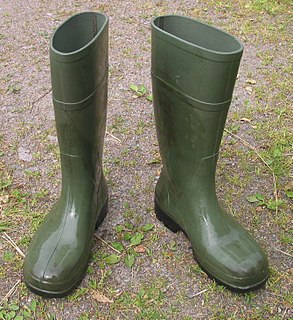
The Wellington boot was originally a type of leather boot adapted from Hessian boots, a style of military riding boot. They were worn and popularised by Arthur Wellesley, 1st Duke of Wellington. The "Wellington" boot became a staple of practical foot wear for the British aristocracy and middle class in the early 19th century. The name was subsequently given to waterproof boots made of rubber and they are no longer associated with a particular class. They are now commonly used for a range of agricultural and outdoors pursuits.
Ski boots are footwear used in skiing to provide a way to attach the skier to skis using ski bindings. The ski/boot/binding combination is used to effectively transmit control inputs from the skier's legs to the snow.

A riding boot is a boot made to be used for horse riding. The classic boot comes high enough up the leg to prevent the leathers of the saddle from pinching the leg of the rider, has a sturdy toe to protect the rider's foot when on the ground and has a distinct heel to prevent the foot from sliding through the stirrup. The sole is smooth or lightly textured to avoid being caught on the tread of the stirrup in the event of a fall.

Chaps are sturdy coverings for the legs consisting of leggings and a belt. They are buckled on over trousers with the chaps' integrated belt, but unlike trousers they have no seat and are not joined at the crotch. They are designed to provide protection for the legs and are usually made of leather or a leather-like material. Their name is a shortened version of the Spanish word chaparreras. Chaparreras were named after the chaparral from which they were designed to protect the legs while riding on horseback. Like much of western horse culture, the origin of chaparreras was in the part of New Spain that later became Mexico, and has been assimilated into cowboy culture of the American west. They are a protective garment to be used when riding a horse through brushy terrain. In the modern world, they are worn for both practical work purposes and for exhibition or show use. Chaps have also been adopted for use on motorcycles, particularly by cruiser-style motorcycle riders.

Combat boots are military boots designed to be worn by soldiers during combat or combat training, as opposed to during parades and other ceremonial duties. Modern combat boots are designed to provide a combination of grip, ankle stability, and foot protection suitable for a rugged environment. They are traditionally made of hardened and sometimes waterproofed leather. Today, many combat boots incorporate technologies originating in civilian hiking boots, such as Gore-Tex nylon side panels, which improve ventilation and comfort. They are also often specialized for certain climates and conditions, such as jungle boots, desert boots, and cold weather boots as well as specific uses, such as tanker boots and jump boots.
Jungle boots are a type of combat boot designed for use in jungle warfare or in hot, wet, and humid environments where a standard leather combat boot would be uncomfortable or unsuitable to wear. Jungle boots have vent holes in the instep and sometimes a canvas upper to aid in ventilation and drainage of moisture.

Mukluks or kamik are a soft boot, traditionally made of reindeer (caribou) skin or sealskin, and worn by Arctic aboriginal people, including the Inuit, Iñupiat, and Yupik.
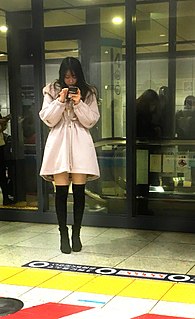
Knee-high boots are boots that rise to the knee, or slightly thereunder or over. They are generally tighter around the leg shaft and ankle than at the top. Originally made of leather, versions made of a synthetic rubber, they are used by fishermen, dairy workers, stable hands, duck hunters, clammers, etc. to protect the feet from water, mud, manure, etc. and to provide traction on slippery surfaces. Most slip on, but there are varieties with buckles and those that lace up.

An Australian work boot is a style of work shoe, typically constructed with a leather upper bound together with elastic sides and pull tabs on the front and back of the boot. The shoe lacks a tongue, and laces, and often contains a steel toe cap for occupational health and safety reasons. When the shoe contains a steel cap they are often known as "safety boots" or "steel toe boots". The boots generally lack an inner lining. The sole is generally polyurethane and the leather uppers are treated to be resistant to hot water, fats and mild alkaline and acid solutions.
Acme Boots was the name of a company that produced boots. It eventually just became a brand name, and was last owned by H.H. Brown, until it was placed under their Double-H Boots brand label.

Chukka boots are ankle-high leather boots with suede or leather uppers, leather or rubber soles, and open lacing, with two or three pairs of eyelets. The name chukka possibly comes from the game of polo, where a chukka is a period of play.

Justin Boots is an American western and equestrian footwear brand. It is a division of Justin Brands, Inc., itself owned by Berkshire Hathaway.
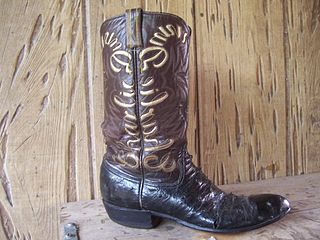
Cowboy boots refer to a specific style of riding boot, historically worn by cowboys. They have a high heel that is traditionally made of stacked leather, rounded to pointed toe, high shaft, and, traditionally, no lacing. Cowboy boots are normally made from cowhide leather, which may be decoratively hand tooled, but are also sometimes made from "exotic" skins like alligator, snake, ostrich, lizard, eel, elephant, stingray, elk, buffalo, and so on.
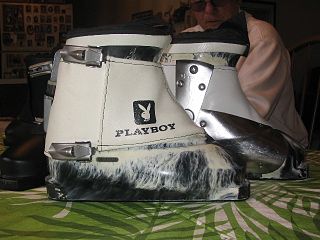
Rosemount Ski Boots introduced one of the earliest all-plastic ski boots for the downhill skiing market, competing with Bob Lange for the title of "first". Rosemount's design was easily distinguished by its use of the uncommon "side-entry" method for putting the boot on, which was rare at the time and is no longer used.
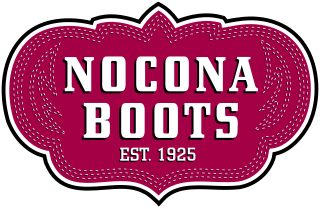
Nocona Boots is a western boot brand and a division of Justin Brands, a Berkshire Hathaway corporation.

The Lucchese Bootmaker Company is a Texas-based, American manufacturer and retailer of luxury level western-inspired footwear and cowboy boots.

Charles Russell Dunn was an American bootmaker of handmade Western, or cowboy, boots for more than 80 years. Dubbed the "Michelangelo of cowboy boots," he first gained widespread notice in the wake of Jerry Jeff Walker's song "Charlie Dunn" (1972). By the time he retired in 1988 from Texas Traditions, his shop in Austin, he routinely charged up to $3,000 for a pair of boots, had a waiting list of hundreds of interested buyers willing to wait three years for delivery, and had made boots for a long list of celebrities, including Arnold Palmer, Mary Kay Place, Gene Autry, Slim Pickens, Don F Brooks, Harry Belafonte, Ernest Tubb, Peter Fonda, and Carole King.
References
- ↑ The real artists of Marfa; Cobra Rock Boot Company February 12, 2012 New York Times (blog)
- ↑ Western Perspective Ep 2 - Cobra Rock Boot Company
- 1 2 Emily Joe Cuerton Boot maker sets up shop in Marfa Archived 2015-10-06 at the Wayback Machine May 12, 2011 Big Bend Sentinel
- ↑ Cobra Rock Boots Natalie Davis August 9, 2012 Tool and Tack (includes screen shot of Anthology Article on Cobra Rock Boots
- ↑ Best of the South 2012 Awards Garden & Gun magazine 2012
- ↑ Western Perspective Ep 2 - Cobra Rock Boot Company Basin PBS series "Western Perspective"
- ↑ "September 27 – 28, 2014 | Texas Country Reporter".
- ↑ Caitlin M. Ryan With love, from Marfa: Cobra Rock Boot Company's handcrafted creations aren't just for cowboys January 16, 2012 Culture Map
- ↑ Designer interview: Cobra Rock Boot Lovejoy September 2012